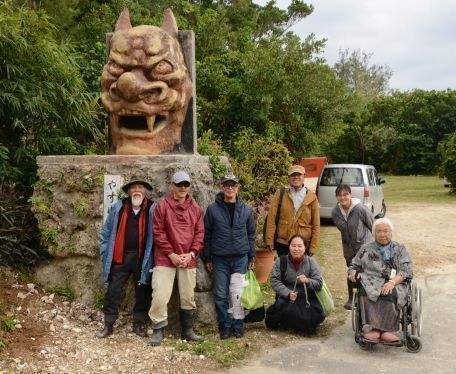The devil’s mask that protects Wabiai no Sato

Creator Minoru Kinjyo (far left) in front of the restored devil mask and Wabiai no Sato Chairman Etsuko Jyabana (far right) and others, taken on February 1 at Wabiai no Sato in Ie Village
February 4, 2019 Ryukyu Shimpo
By Shouhei Tsukazaki
The Wabiai no Sato in Higashiemae of Ie Village in Okinawa Prefecture works to pass on the history of Ie Island and the footsteps of late peace activist Shoukou Ahagon. Above the gate to the Wabiai no Sato is a devil’s mask, which had been deteriorating badly over time. Creator and sculptor Minoru Kinjyo, 80, completed the restorations of the mask on February 3. Kinjyo added some improvements to the original craftsmanship to which he said, “It went well, so I’m satisfied.” He stared at the mask and thought nostalgically about the late Ahagon.
The devil’s mask stands about 1.9 meters (6.2 feet) tall and was created in 1987. At the time it was created, a typhoon had been approaching, so ships could not leave the Motobu Port. In the end, the mask was made in Nago City and was brought to the island. Since it was created in a short amount of time, Kinjyo said “the craftmanship was not satisfactory” and had regrets about it.
Maja in the same village is where Ahagon and others used Danketsu Dojo (Unity Dojo) as their base of operations for their peace activities. The restoration of the mask was intentionally carried out at the same time this dojo was being restored. It took four days, which involved replacing the steel frame and concrete for the foundation. Kinjyo fulfilled his longstanding wish. He said, “It had been more than 30 years, so the deterioration was very bad. I’m satisfied with the result.”
Kinjyo pointed out that the reason why he chose a devil as the motif was because the way mainland Japan and Okinawa view devils are different. The Okinawan “moochee” is derived from mochi used for memorial services for both the devil who ate children and the children who were eaten by the devil. Meanwhile in the mainland, Kinjyo cites “kichiku beiei” (Americans and British are brutes) that was frequently used during the war as one example.
Kinjyo explained that, “Devils were used for aggressive wars and antiforeignism. Meanwhile ‘moochee’ is the same as the foundation of peace, where a memorial service is held both for the assailant and victim.” He also emphasized that “(With the Okinawan understanding of the devil,) It matches Teacher Shoukou Ahagon’s peace theory that embraces all religions.”
“When Ahagon was alive, he had said, ‘This devil mask is the gatekeeper to make sure bad things do not enter the Wabiai no Sato.’ It is something that will remain semi-permanent and holds significant meaning,” said Wabiai no Sato Chairman Etsuko Jabana happily.
(English translation by T&CT and Chelsea Ashimine)
Previous Article:Expert claims no previous reinforcement of soft ground 90 meters below sea level, the depth found in Henoko construction area
Next Article:Nakandakari Ward holds ceremony to transplant young rice plants and pray for good harvest
[Similar Articles]
- Fundraising begins to repair and preserve “Solidarity Dojo,” symbol of resistance to US military
- Inheriting non-violent way of life from father of the Okinawan civil rights movement
- Nuchi-du-Takara-no-Ie celebrates 30th anniversary
- “Lobbying Journal” detailing the “beggars’ march” is published
- Shoko Ahagon’s legacy of the Ie Land Struggle and Solidarity Dojo passed on to Ie Elementary School students
 Webcam(Kokusai Street)
Webcam(Kokusai Street)


